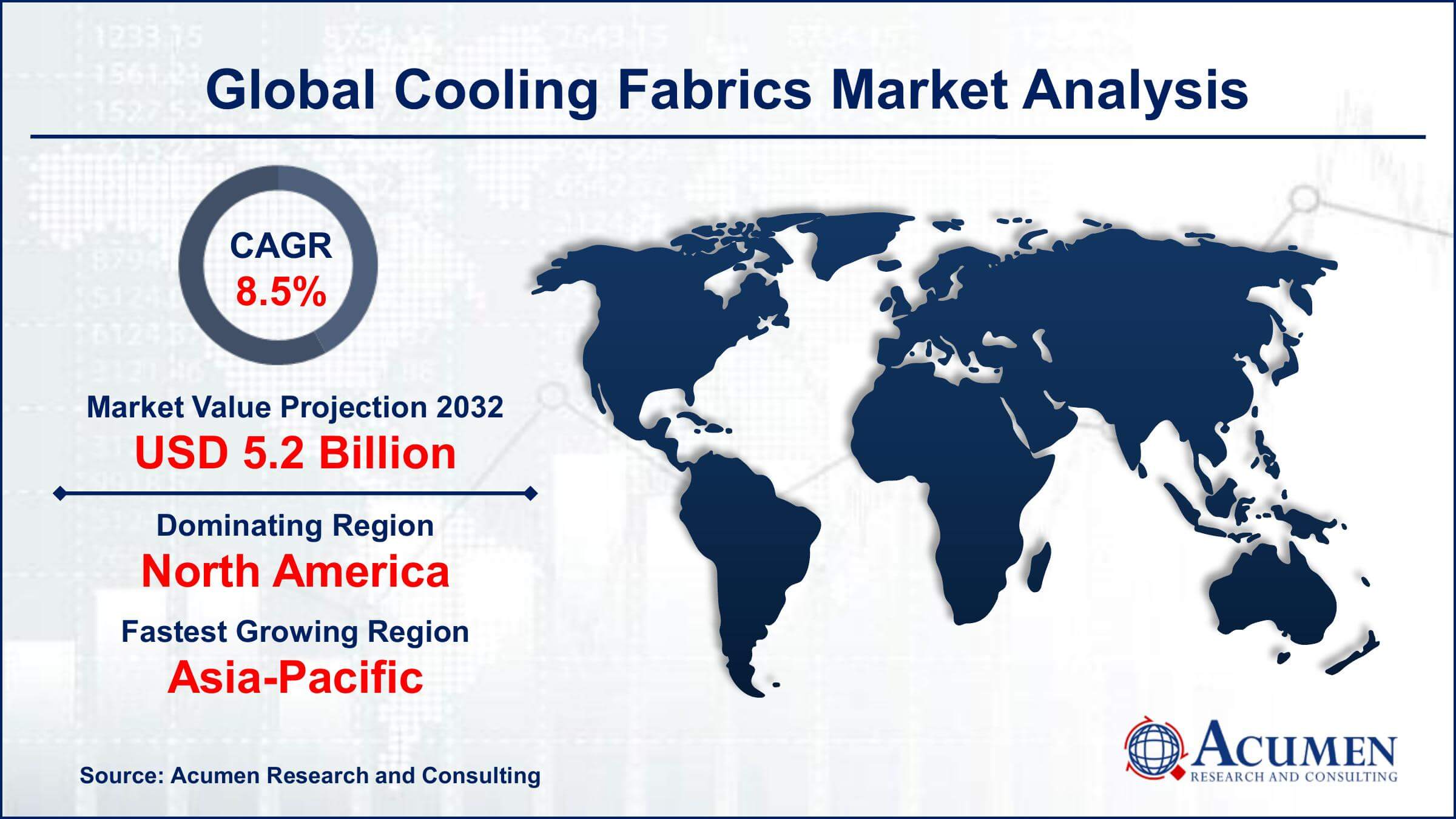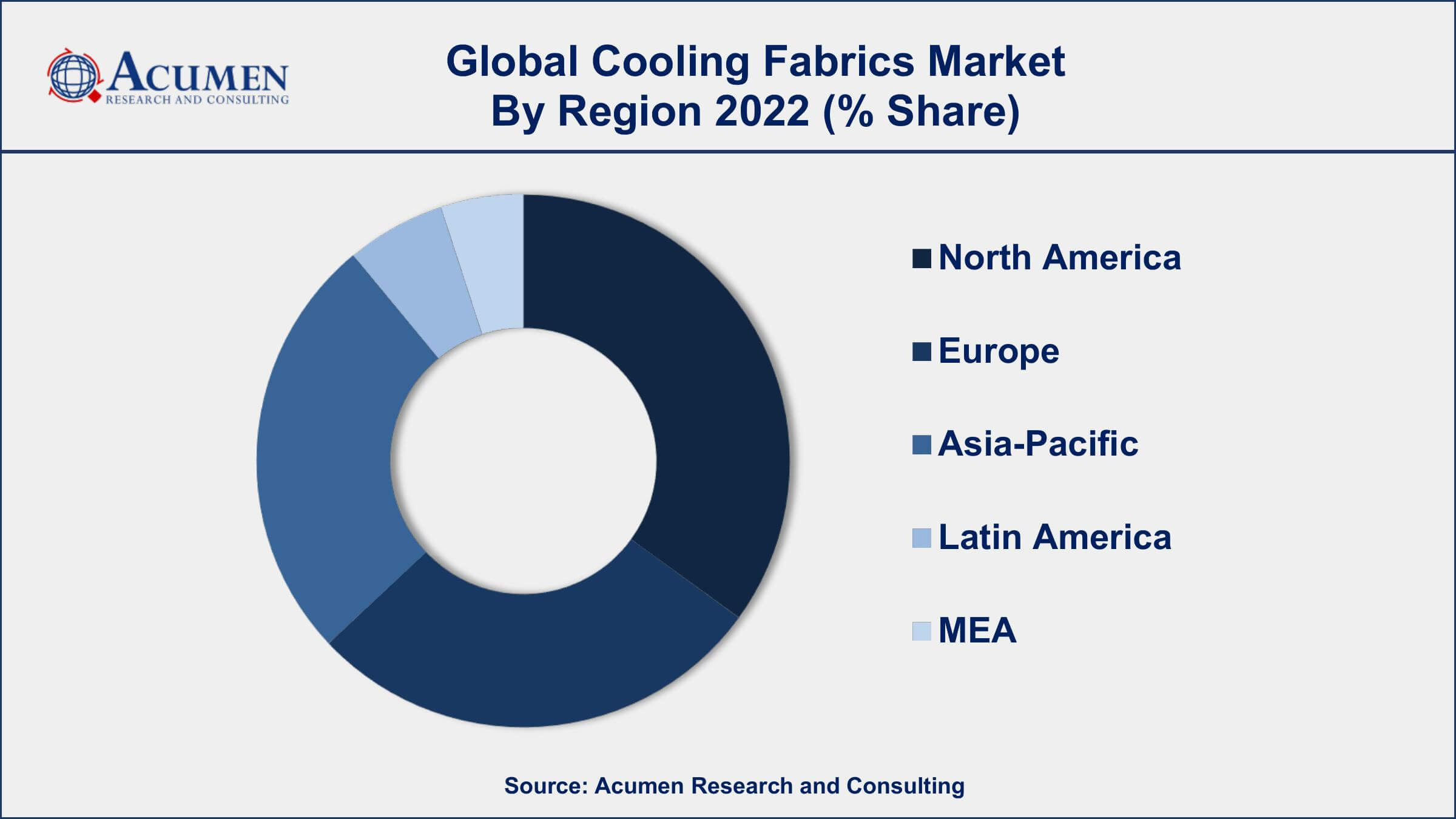Cooling Fabrics Market Size - Global Industry, Share, Analysis, Trends and Forecast 2023 - 2032
Published :
Report ID:
Pages :
Format :
Cooling Fabrics Market Size - Global Industry, Share, Analysis, Trends and Forecast 2023 - 2032
Report Coverage
- Industry Dynamics
- Market Size and Forecast Data
- Segment Analysis
- Competitive Landscape
- Regional Analysis with a Niche Focus on Country-Level Data
- High Level Analysis - Porter's, PESTEL, Value Chain, etc.
- Company Profiles of Key Players
- Option to Customize the Report As Per Your Specific Need
Request Sample Report
The Global Cooling Fabrics Market Size accounted for USD 2.3 Billion in 2022 and is projected to achieve a market size of USD 5.2 Billion by 2032 growing at a CAGR of 8.5% from 2023 to 2032.
Cooling Fabrics Market Highlights
- Global Cooling Fabrics Market revenue is expected to increase by USD 5.2 Billion by 2032, with a 8.5% CAGR from 2023 to 2032
- North America region led with more than 39% of Cooling Fabrics Market share in 2022
- Asia-Pacific Cooling Fabrics Market growth will record a CAGR of around 9.2% from 2023 to 2032
- By type, the synthetic segment is the largest segment in the market, accounting for over 67% of the market share in 2022
- By fabric type, the knit segment has recorded more than 38% of the revenue share in 2022
- Rising demand for comfortable and performance-enhancing apparel, drives the Cooling Fabrics Market value

Cooling fabrics, also known as smart textiles or temperature-regulating textiles, are innovative materials designed to manage body heat and provide a cooling effect to the wearer. These fabrics utilize various technologies to achieve their cooling properties, such as phase change materials, moisture-wicking technologies, and thermal radiation manipulation. The goal of cooling fabrics is to enhance comfort in warm environments or during physical activities by actively regulating the body's temperature, wicking away moisture, and facilitating better air circulation.
The market for cooling fabrics has witnessed significant growth in recent years due to the increasing demand for comfortable and performance-enhancing apparel in various sectors. Athletes, outdoor enthusiasts, and individuals in regions with high temperatures have shown a strong interest in clothing that can provide effective cooling while maintaining style and functionality. Additionally, advancements in textile engineering and materials science have led to the development of more efficient cooling fabric technologies, driving innovation and expanding the market's potential. As consumers become more conscious of the impact of temperature on their well-being, the demand for cooling fabrics is projected to continue its upward trajectory.

Global Cooling Fabrics Market Trends
Market Drivers
- Rising Demand for Comfortable and Performance-Enhancing Apparel
- Increasing Awareness of Temperature-Regulating Benefits
- Growing Interest from Athletes and Outdoor Enthusiasts
- Advancements in Textile Engineering and Materials Science
- Urbanization and Climate Change Impacting Demand
Market Restraints
- High Production Costs of Innovative Cooling Technologies
- Limited Longevity and Durability of Some Cooling Fabrics
Market Opportunities
- Expansion into Medical and Healthcare Textile Applications
- Consumer Desire for Sustainable and Energy-Efficient Solutions
Cooling Fabrics Market Report Coverage
| Market | Cooling Fabrics Market |
| Cooling Fabrics Market Size 2022 | USD 2.3 Billion |
| Cooling Fabrics Market Forecast 2032 | USD 5.2 Billion |
| Cooling Fabrics Market CAGR During 2023 - 2032 | 8.5% |
| Cooling Fabrics Market Analysis Period | 2020 - 2032 |
| Cooling Fabrics Market Base Year | 2022 |
| Cooling Fabrics Market Forecast Data | 2023 - 2032 |
| Segments Covered | By Type, By Fabric Type, By Application, And By Geography |
| Regional Scope | North America, Europe, Asia Pacific, Latin America, and Middle East & Africa |
| Key Companies Profiled | Coolcore LLC, Columbia Sportswear, Outlast Technologies LLC, Polartec LLC, Nan Ya Plastics Corporation, Ventex Co., Ltd., Ahlstrom-Munksjö, Tex-Ray Industrial Co., Ltd., Nilit Ltd., HexArmor, Nanjing Textiles Import & Export Corp. Ltd., and Adidas |
| Report Coverage |
Market Trends, Drivers, Restraints, Competitive Analysis, Player Profiling, Covid-19 Analysis, Regulation Analysis |
Cooling fabrics are specialized textiles engineered to provide a cooling sensation to the wearer's skin. These fabrics utilize various technologies to manage body heat and moisture, enhancing comfort and maintaining optimal body temperature. The primary aim of cooling fabrics is to dissipate heat and promote better air circulation, making them particularly suitable for use in warm and active environments.
The applications of cooling fabrics are diverse and span across several industries. In sports and athletics, these fabrics are integrated into activewear, such as workout clothing, sports uniforms, and athleisure wear. They help athletes remain comfortable and perform better by preventing overheating during intense physical activities. Furthermore, cooling fabrics find utility in outdoor apparel, including hiking gear, camping attire, and swimwear, where maintaining a cool body temperature is crucial to prevent heat-related discomfort. Beyond sport and outdoor activities, cooling fabrics also have applications in medical textiles. They can be utilized in hospital gowns, bedding, and wound dressings to provide a soothing and cooling effect to patients.
The cooling fabrics market has experienced robust growth over the past few years, driven by a convergence of factors that have propelled its popularity and adoption across various industries. With rising global temperatures and increased awareness of the importance of thermal comfort, the demand for innovative solutions to regulate body temperature has surged. As a result, cooling fabrics have gained significant traction, particularly in sportswear, athleisure, and outdoor apparel segments. The market's growth has been further accelerated by advancements in material science and textile engineering, which have led to the development of more efficient and versatile cooling technologies. Athletes, fitness enthusiasts, and individuals seeking relief from heat stress have fueled the market's expansion.
Cooling Fabrics Market Segmentation
The global Cooling Fabrics Market segmentation is based on type, fabric type, application, and geography.
Cooling Fabrics Market By Type
- Synthetic
- Natural
According to the cooling fabrics industry analysis, the synthetic segment accounted for the largest market share in 2022. This segment's growth can be attributed to factors such as the increasing demand for high-performance apparel, rising awareness of thermal comfort, and advancements in textile engineering. Synthetic cooling fabrics are being widely adopted in sportswear, activewear, and outdoor apparel due to their moisture-wicking properties, breathability, and quick-drying capabilities. These fabrics efficiently draw moisture away from the body, enhancing comfort during physical activities and in hot conditions. The growth of e-commerce and the convenience of online shopping have also contributed to the popularity of synthetic cooling fabrics, as consumers seek innovative solutions that provide both style and functionality.
Cooling Fabrics Market By Fabric Type
- Woven
- Knit
- Non-woven
- Others
In terms of fabric types, the knit segment is expected to witness significant growth in the coming years. This segment's growth can be attributed to factors such as the demand for comfortable activewear, advancements in knitting technology, and the rise of athleisure trends. Knit cooling fabrics offer a seamless and close-to-body fit, allowing for optimal moisture-wicking and ventilation. The construction of knit fabrics enables the incorporation of various cooling technologies, such as mesh panels, open-knit structures, and moisture-wicking yarns, to enhance their cooling performance. This has made them particularly popular in sports apparel, yoga wear, and casual activewear where movement, comfort, and temperature regulation are crucial. The growth of the athleisure market, which blends fashion with functionality, has further propelled the knit segment's expansion.
Cooling Fabrics Market By Application
- Sports Wear
- Apparels
- Protective Wear
- Others
According to the cooling fabrics market forecast, the sports wear segment is expected to witness significant growth in the coming years. Cooling fabrics have played a pivotal role in this segment's growth by addressing the need for effective moisture management, temperature regulation, and overall comfort during physical activities. One of the primary drivers of the sportswear segment's growth is the integration of advanced cooling technologies into garments. Innovative materials such as moisture-wicking fabrics, microfiber blends, and phase change materials (PCMs) have allowed sports apparel manufacturers to create garments that actively draw sweat away from the body, prevent overheating, and enhance the overall workout experience. Athletes and fitness enthusiasts, in particular, have gravitated towards sports clothing that offers not only functional benefits but also a competitive edge in terms of performance enhancement.
Cooling Fabrics Market Regional Outlook
North America
- U.S.
- Canada
Europe
- U.K.
- Germany
- France
- Spain
- Rest of Europe
Asia-Pacific
- India
- Japan
- China
- Australia
- South Korea
- Rest of Asia-Pacific
Latin America
- Brazil
- Mexico
- Rest of Latin America
The Middle East & Africa
- South Africa
- GCC Countries
- Rest of the Middle East & Africa (ME&A)

Cooling Fabrics Market Regional Analysis
North America's dominance in the cooling fabrics market can be attributed to a combination of factors that have propelled the region to the forefront of this industry. One key factor is the region's well-established sports and fitness culture, with a significant portion of the population engaging in various physical activities and outdoor sports. This has driven a substantial demand for high-performance activewear and sportswear that incorporates cooling technologies to enhance comfort during workouts and outdoor pursuits. Furthermore, North America boasts a robust textile and apparel industry with a strong emphasis on innovation and research. The region is home to many leading manufacturers, brands, and research institutions that have been at the forefront of developing and implementing cooling fabric technologies. This ecosystem of innovation has enabled North American companies to pioneer advancements in textile engineering, leading to the creation of fabrics with superior moisture-wicking, breathability, and thermal regulation properties.
Cooling Fabrics Market Player
Some of the top cooling fabrics market companies offered in the professional report include Coolcore LLC, Columbia Sportswear, Outlast Technologies LLC, Polartec LLC, Nan Ya Plastics Corporation, Ventex Co., Ltd., Ahlstrom-Munksjö, Tex-Ray Industrial Co., Ltd., Nilit Ltd., HexArmor, Nanjing Textiles Import & Export Corp. Ltd., and Adidas.
Frequently Asked Questions
What was the market size of the global cooling fabrics in 2022?
The market size of cooling fabrics was USD 2.3 Billion in 2022.
What is the CAGR of the global cooling fabrics market from 2023 to 2032?
The CAGR of cooling fabrics is 8.5% during the analysis period of 2023 to 2032.
Which are the key players in the cooling fabrics market?
The key players operating in the global market are including Coolcore LLC, Columbia Sportswear, Outlast Technologies LLC, Polartec LLC, Nan Ya Plastics Corporation, Ventex Co., Ltd., Ahlstrom-Munksj�, Tex-Ray Industrial Co., Ltd., Nilit Ltd., HexArmor, Nanjing Textiles Import & Export Corp. Ltd., and Adidas.
Which region dominated the global cooling fabrics market share?
North America held the dominating position in cooling fabrics industry during the analysis period of 2023 to 2032.
Which region registered fastest CAGR from 2023 to 2032?
Asia-Pacific region exhibited fastest growing CAGR for market of cooling fabrics during the analysis period of 2023 to 2032.
What are the current trends and dynamics in the global cooling fabrics industry?
The current trends and dynamics in the cooling fabrics industry include rising demand for comfortable and performance-enhancing apparel, increasing awareness of temperature-regulating benefits, and growing interest from athletes and outdoor enthusiasts.
Which fabric type held the maximum share in 2022?
The knit fabric type held the maximum share of the cooling fabrics industry.


